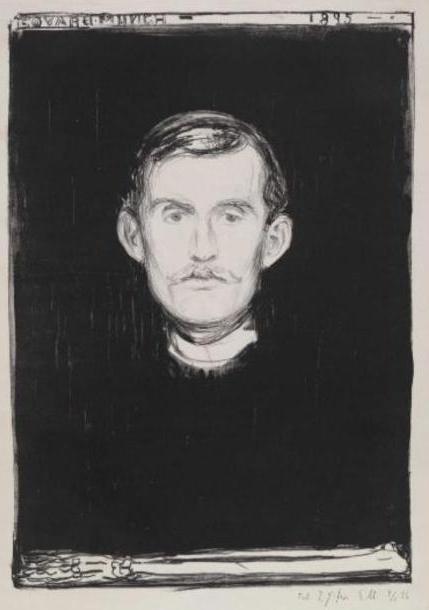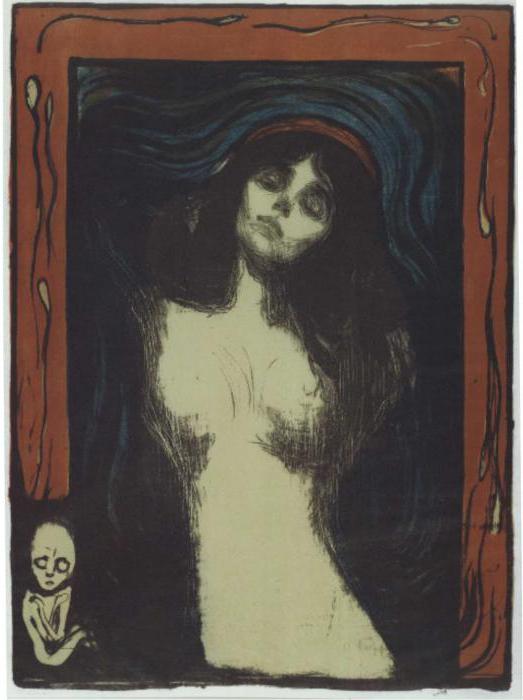Edward Munch (1863-1944) formulated his credo as a desire to write living people, breathing, suffering, loving - "people taking off their hats in front of the entrance to the church." In expressing strong human emotions, the means of classical realism were not enough for him, he opened up new paths in art, much ahead of his time.
He was looking for new artistic means of painting, he reinterpreted classic subjects. A vivid example of this search was the painting "Madonna". Munch was inspired by a theme born a thousand years ago, but the result was a work relevant for any time.
Forerunner of Expressionism
In his development as a painter, Munch went through periods of fascination with a variety of approaches to the reflection of the world. He has works created in a classic, realistic manner. He painted landscapes in the style of the Impressionists, experienced the powerful influence of the French Symbolists. As a result, the master created his own creative method, which does not allow attributing it to a specific course. The closest to the work of the great Norwegian is the painting of Gauguin and, especially, Van Gogh. But in reality they are only related by the power of the energy radiated by their works - the originality of the pictorial manner and the features of the artistic analysis of the world are too obvious.

In this sense, the painting “Madonna” by Munch contains all the signs of the originality of his painting. These include unprecedented frankness in the unexpected interpretation of the classic plot, which was called scandalous, laconic composition and the unique technique of image construction. Smooth, viscous lines of the picture and a viscous background in which details that are insignificant for the realization of the general idea are hidden - in this manner all the most significant things of the master are created in which it is customary to see signs of new art of the 20th century.
Is this Madonna?
The debate about whether the painting “Madonna” by Munch is really an image of the Virgin, the Virgin Mary, flared up immediately after writing the first version of the canvas in 1893. The only indication of the divine origin of the depicted woman is a halo above her head, moreover, an unusual - red - color. It is known that at first the painting was called by the artist Kvinne som elsker - literally - a woman makes love. The name that later appeared, referring to the classical creations that have been known since the early Middle Ages, to the great works of Renaissance masters, adds a new depth to the original plan.

One of the reasons for choosing such a plot by the master and the way the painting “Madonna” by Munch meets the religious view of the artist, researchers of his work explain the tragic events of his youth. Born in a family where his father, a military doctor Christian Munch, was distinguished by painful religiosity, Edward at first deeply perceived Christian postulates. But after the death of his beloved elder sister - Sofia, after he watched the prayer cries of his father, who could not help the dying, he finally became disillusioned with the traditional religion. And the Madonna in his picture became only a symbol, and the theme of the canvas was life and love - female and male.
"The frieze of life"
In 1903, in one of the halls of the Berlin Secession - an exhibition of artists who denied traditional, academic art - Munch first exhibited the first works from a series of paintings, which, in his opinion, should cover the main periods of life, the main aspects of human life. He called it "The Frieze of Life" and continued to work on it for almost his entire life.
For the artist, the order of placing the paintings, which were hung out according to several sections, was important. "Madonna" - a picture of Munch - was painted by him for "Frieze" and related to the section "Birth of love." In addition, there were others: “The Prosperity and Sunset of Love”, “Fear of Life” (which included the famous “Scream” (1893)), and “Death”.
The exact composition of the sections has not been preserved and is being restored according to the memoirs of contemporaries, but the fact that the topic of the relationship between a man and a woman was one of the main components of the Frieze is also known from the texts of the master.
A moment of love
In total, five versions of the picture were created - lithographic and made with oil paints. Each of them is not just a blind repetition, but a gradual development of the theme, complementing the design with new nuances and details. In one of the graphic options, the artist frames the picture with a symbolic image of a life-giving liquid, placing a small human embryo at the end. The fact that "Madonna" - a picture of Munch, depicting a woman at the time of love, becomes clear even more clearly.

But the depth and volume of truly great paintings, does not allow too simple interpretations. The masterpiece belonging to the highest level - “Madonna”, a picture of Munch. The Woman is depicted on it - earthly and living - her body is represented in such round and hot lines, the passion in the eyes and features of her face is so pronounced, the pose seems natural if we assume that we are facing, not a standing model. Why is the picture radiating such drama, why does the fetus of the future fruit of love look dead? To explain this with the general gloomy message emanating from the work of the artist, who had a broken psyche, is too lightweight - higher powers lead the hand of the great master.
The Thinker and the Prophet
His creations now see the omens of the global world turmoil of the 20th century. In the last decades of his life, he knew success and recognition, and died in 1944 in his native Norway, in a country captured by fascists - connoisseurs of another art - preaching clear and understandable truths, in a language accessible to the most unicellular creature.
His paintings set price records at auctions, and incredible stories take place with them: Madonna, a painting by Edward Munch, was stolen from an Oslo museum in 2004 by two armed robbers, along with one of the master’s other masterpiece variants, Scream. For a year, their whereabouts were unknown, although the robbers were found and convicted. There was information about their final loss. But the canvases returned to the museum, although somewhat damaged.
The main advantage of works such as Madonna is that they provide an opportunity to find answers to the most important questions of being, but only to those who pose such questions and those who seek such answers.